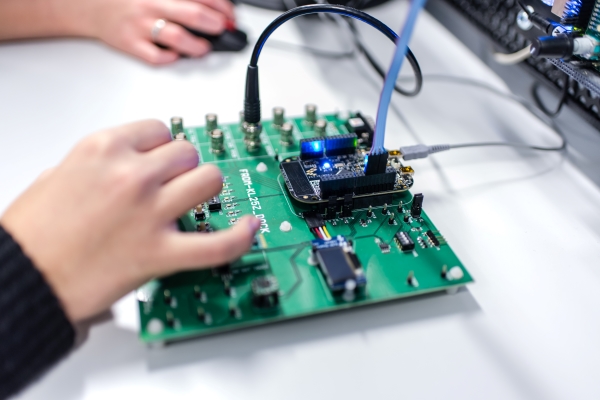- Signal Transmission
Analog and discrete signal. Signals and Signal Frequencies. Simplex and duplex communication (radio, television x telephone). Concepts of backbone and access network.
- Communication networks
Signaling and synchronization in communication networks. Backbone and Access Network technologies.
- Metallic networks
Symmetrical and asymmetric lines. Replacement management model. Attenuation, Crosstalk. Effect of capacitance imbalance on line transfer function. Bridging targeting methods.
- Optical networks
Advantages and disadvantages of aerial optical paths, LASER and LED connectors. The principle of light transmission by fiber optic. Total reflection. Attenuation in opt fibers. Spectral attenuation characteristic of opt fibers. Dispersions in optical fibers. Spectrum of semiconductor light sources for opt. WDM networks.
- Access networks
xDSL technology (overview, principles, ...) DOCSIS technology.
- Wireless networks
Distribution of Radio Spectrum. Basics of radio signal propagation, radiocommunications chain, overview of radio channel systems (Wifi-BT-Wimax-Zigbee).
- Computer Networks I
TCP/IP model and architecture, relationship to RM OSI model. Datagram, packet, frame, encapsulation. MAC address, IPv4 and IPv6 addresses. TCP and UDP transport protocols. Ethernet and its types.
- Computer Networks II
Networks active elements - HUB, switch router, fundamentals of routing (routing protocols - RIP, OSPF, BGP). Advanced services in networking - DHCP, NAT, DNS.
- Mobile technologies
1st and 2nd generation mobile networks (overview) - 3rd and 4th generation mobile networks (UMTS, LTE). Data mobile networks (HSCSD, GPRS, EDGE, HSPA, LTE).
- Safety of communications
The role of cryptography and the cryptographic system. Confidentiality, integrity, authentication, access control. Overview of ciphers and algorithms, hash functions and digital signature. Future of cryptography - quantum key distribution.
- Multimedia Communications I
Multimedia features. Protocols suitable for real-time transmission of information. Codecs for voice and quality transmission parameters.
- Multimedia Communications II
Video, Color models - RGB, CMY, CMYK, YUV. HD, Full HD and UHD resolution. Picture and video processing options, compression, formats and containers. Video distribution methods.
- The concept of the Internet of things
Description of technology and used transmission networks, principles of information transfer in IoT infrastructure, introduction to protocols and usage possibilities, overview of hardware and functional possibilities.
Analog and discrete signal. Signals and Signal Frequencies. Simplex and duplex communication (radio, television x telephone). Concepts of backbone and access network.
- Communication networks
Signaling and synchronization in communication networks. Backbone and Access Network technologies.
- Metallic networks
Symmetrical and asymmetric lines. Replacement management model. Attenuation, Crosstalk. Effect of capacitance imbalance on line transfer function. Bridging targeting methods.
- Optical networks
Advantages and disadvantages of aerial optical paths, LASER and LED connectors. The principle of light transmission by fiber optic. Total reflection. Attenuation in opt fibers. Spectral attenuation characteristic of opt fibers. Dispersions in optical fibers. Spectrum of semiconductor light sources for opt. WDM networks.
- Access networks
xDSL technology (overview, principles, ...) DOCSIS technology.
- Wireless networks
Distribution of Radio Spectrum. Basics of radio signal propagation, radiocommunications chain, overview of radio channel systems (Wifi-BT-Wimax-Zigbee).
- Computer Networks I
TCP/IP model and architecture, relationship to RM OSI model. Datagram, packet, frame, encapsulation. MAC address, IPv4 and IPv6 addresses. TCP and UDP transport protocols. Ethernet and its types.
- Computer Networks II
Networks active elements - HUB, switch router, fundamentals of routing (routing protocols - RIP, OSPF, BGP). Advanced services in networking - DHCP, NAT, DNS.
- Mobile technologies
1st and 2nd generation mobile networks (overview) - 3rd and 4th generation mobile networks (UMTS, LTE). Data mobile networks (HSCSD, GPRS, EDGE, HSPA, LTE).
- Safety of communications
The role of cryptography and the cryptographic system. Confidentiality, integrity, authentication, access control. Overview of ciphers and algorithms, hash functions and digital signature. Future of cryptography - quantum key distribution.
- Multimedia Communications I
Multimedia features. Protocols suitable for real-time transmission of information. Codecs for voice and quality transmission parameters.
- Multimedia Communications II
Video, Color models - RGB, CMY, CMYK, YUV. HD, Full HD and UHD resolution. Picture and video processing options, compression, formats and containers. Video distribution methods.
- The concept of the Internet of things
Description of technology and used transmission networks, principles of information transfer in IoT infrastructure, introduction to protocols and usage possibilities, overview of hardware and functional possibilities.
